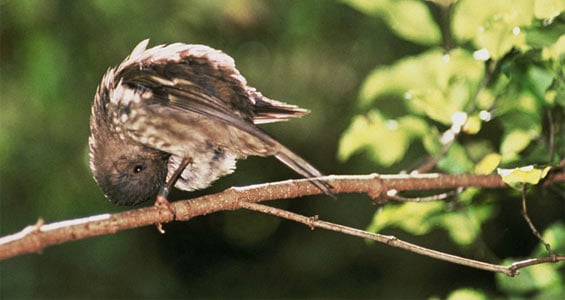New Zealand status: Endemic
Conservation status: Threatened–Nationally Vulnerable
Found in: Naturally surviving on Te Hauturu-o-Toi (Little Barrier Island) and have been reintroduced to seven other sites
Threats: Predation, habitat loss, disease
Sound recording:
Hihi/stitchbird song (MP3, 3,830)
04:04 – Adult territorial calls.
Species information: Stitchbird on NZ Birds Online
Hihi conservation
In pre-European times, hihi were found throughout the North Island and on several islands such as Aotea (Great Barrier), Te Hauturu-o-Toi and Kapiti. Sadly, the species became extinct on the mainland with the last recorded sighting in the Tararua Ranges in 1883.
Did you know?
Hihi are also the only birds known to sometimes mate face to face.
Habitat loss, the introduction of mammalian predators such as cats and rats and specimen collection probably contributed to the decline of hihi on the mainland. They disappeared soon after European colonisation. They also appear to be especially prone to the effects of diseases, which may have arrived to New Zealand with introduced or domestic birds.
Hihi research
An active research programme with a range of universities (including international universities), has greatly increased our knowledge of hihi biology.
Hihi have been found to have a fascinating and complex mating system. Males pair up with a female in their territory while also seeking to mate with other females in the neighbourhood.

The hihi is one of New Zealand’s rarest birds. The female birds (pictured) have more subdued colouring and look quite different to the male birds.
Image: Garry Norman/Mount Bruce Wildlife Centre ©
To ensure the chicks are his, males need to produce large amounts of sperm to dilute that of other males. And to avoid wasting this, the male has to assess exactly when a female is ready to breed. In the days leading up to laying, when a female is weighed down with developing eggs, a number of males may chase her for hours at a time, all attempting to mate with her.
A key strength of the Hihi Recovery Group is the research partners which are part of it. Hihi populations provide a world-renowned study system in small population recovery and reintroduction biology.
Each year, researchers produce high-quality science examining hihi behavioural ecology, genetics, conservation, and more. Many of these studies directly inform hihi management and go on to be published in peer-reviewed, specialist scientific journals.
Regular updates on research publications can be found on the Hihi Conservation website.
Recovery plan
DOC's Hihi Recovery Plan is being reviewed, but our objectives are to:
- Increase the total number of hihi nationwide. We aim to increase the number of hihi populations across Aotearoa New Zealand and the total number of hihi in them.
- Increase the natural ecological setting of the hihi. Nest boxes and sugar water are provided to help hihi survive and reproduce, but we want more natural sites without the need for these.
- Reduce the cost of managing hihi populations. Managing hihi bears many financial costs which we want to minimise. Two major expenses are the provision of nest boxes and sugar water.
- Increase awareness and appreciation of hihi.
Translocations
The only naturally surviving population of hihi is found on Te Hauturu-o-Toi in the Hauraki Gulf.
DOC and communities have carried out a series of translocations of hihi from Te Hauturu-O-Toi to other secure sites. Early attempts to establish birds on Hen, Mokoia (Lake Rotorua) and Cuvier islands and at Art in the Park, Waitakere Ranges were not successful without supporting management. Later transfers to Kapiti and Tiritiri Matangi trialled new management techniques to assist the hihi to survive.
There are now small managed populations of hihi on Tiritiri Matangi and Kapiti islands, as well as Zealandia in Wellington, Bushy Park near Wanganui, Maungatautari, Rotokare and Shakepear Regional Park.
Communities and DOC now support these populations by providing nectar feeders and sometimes artificial nest boxes. Staff closely monitor breeding activity during the summer season. In some locations, nest boxes are also sprayed to prevent mite infestations that can kill young chicks.
You can help
You can help by donating to Hihi Conservation Charitable Trust via Give a little.
